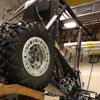
Trevor Smith had a couple of firsts in his final year at Kettering University. He was part of a capstone class team that prepared the first vehicle to be tested using the new Durability Test Lab equipment and the first to run durability tests on a Kettering SAE competition vehicle for his thesis project.
“The Durability Test Lab (a.k.a. the Shaker Lab) is fairly new to Kettering,” explained Smith of his ‘firsts.’ Until his thesis project there had only been one vehicle that had been tested using the new equipment, a 2007 Ford Escape Hybrid.
“The vehicle testing on the Escape was prepared by my capstone project team and then was displayed during a Discover Kettering open house in 2010,” said Smith. “Our demonstration developed interest in a number of parties, including the Kettering SAE Mini Baja competition team.”
Kettering capstone classes are geared for seniors, and bring together all the knowledge a student has acquired in their field of study in one project to test their understanding of that area of engineering. In addition, all Kettering undergraduates must complete a thesis project designed to combine academic curriculum and work experience into a significant professional project for their co-op employer. The student performs the project, writes a comprehensive report describing their work (the thesis) and is evaluated by both their employer advisor and their faculty advisor.
Smith’s thesis project, entitled "Mechanical System Durability Test Fixturing & Analysis,” focused on testing the SAE Mini Baja team vehicle using the Shaker lab. “The SAE Baja team had never had any sort of durability test which would contribute to a key aspect of their design,” said Smith. “They compete in various events that all rely on the overall integrity of their vehicle as a system, and need to design for durability.”
Mini Baja vehicles are a special kind of four-wheeled vehicle used for recreational and exploration purposes. They are designed for off road use and for endurance of rough terrain. In many aspects they are similar to an All-Terrain Vehicle (ATV) except that they have safer rollover capabilities.
“The direct goal of the (Shaker) lab is to have robust fixtures set-up for mechanical systems and to have developed appropriate testing scenarios/procedures,” he said. Having the new durability lab could result in new curriculum opportunities in the area of vibration/wave analysis as well as further the University’s knowledge of the equipment/software used for durability testing, according to Smith.
Having the fixtures withstand numerous tests as well as performing the requirements provided by the SAE Baja team will be used for evaluation of the lab’s set-up and test procedures, he added.
The Montrose, Mich. native graduated in June 2011 with a Bachelor’s of Science degree in Mechanical Engineering with an Automotive Systems Design specialty. During his tenure at Kettering he held cooperative education positions with Delphi Steering Saginaw (now Nexteer Automotive) and Magna Electronics in Holly, Mich.
Smith currently works at Chrysler LLC in the Powertrain Adaptation group. He would like to work as a Design and Release engineer on the initial design, packaging, development, sourcing, and production tooling of fuel systems, electronic throttle control systems, or exhaust gas recirculation systems.
While he will be indirectly involved with durability testing while in this position, “there will be opportunities to become more involved depending on the group and engine programs I work with,” he said. “The experience and knowledge I have gained from my thesis project and my vehicle design course will provide useful insight when dealing with component/vehicle durability testing,” he added.
Contact: Dawn Hibbard
810.7562.9865
dhibbard@kettering.edu